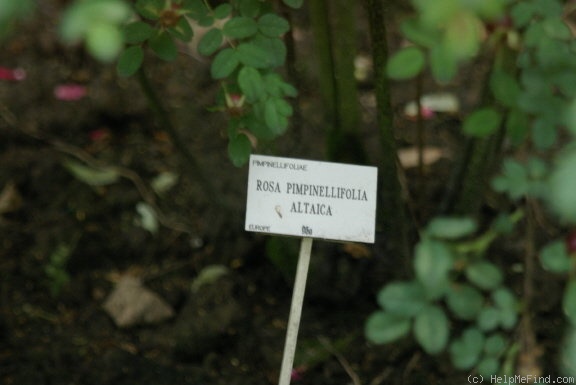|
|
'R. spinosissima var. altaica' rose Description

Photo courtesy of David Elliott
ARS:
White, near white or white blend Species.
Exhibition name: R. spinosissima var. altaica
Bloom:
Cream to white, yellow stamens. Mild fragrance. 5 petals. Average diameter 3". Large, single (4-8 petals), flat bloom form. Once-blooming spring or summer.
Habit:
Armed with thorns / prickles, bushy, suckers on its own roots, upright, well-branched. Matte, attractive fall color foliage. 7 to 9 leaflets.
Height: 4' to 6' (120 to 185cm).
Growing:
USDA zone 4a and warmer. Can be used for hedge, landscape or shrub. Hardy. drought resistant. produces decorative hips. Disease susceptibility: disease resistant. Needs little care; relatively disease-free and quite hardy. Prune dead wood.
Patents:
Patent status unknown (to HelpMeFind).
Parentage:
If you know the parentage of this rose, or other details, please contact us.
Notes:
The identity and correct name of this rose has been in dispute for 300 years!
Willdenow first named this rose Rosa altaica in Enumeratio Plantarum Horti Regii Botanici Berolinensis (1809) by renaming of the rose described by Pallas in 1789, who called it R. pimpenellifolia. The modern name is described as :
Rosa spinosissima var. altaica (Willd.) Rehder (1902)
or
Rosa spinosissima var. altaica (Willd.) Bean (1895)
or
If you accept the name R. pimpinellifolia as the correct name of the species instead of spinosissima, then the name of this rose is:
R. pimpinellifolia L. var. altaica (Willd.) Thory (1820)
Bean distinguishes the species, by any name, from the cultivar 'Grandiflora' as described by Lindley, which is shown with different bloom color (creamy white rather than yellowish white) and with different armature (a scarcity or absence of bristles among the prickles). The plant appeared in European gardens by the 1820's.
To be thoroughly confused, see References.
The Swedish Rose Society recommends Rosa pimpinellifolia var. altaica for northern Sweden. Sheila Holmes says Altai roses come from the Altai Mountains in Asia.
|